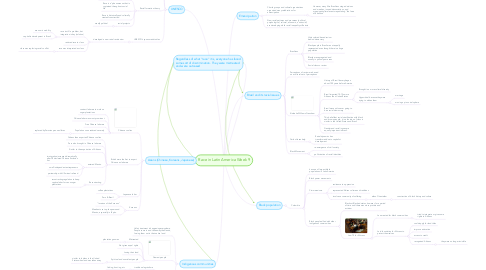
1. UNESCO
1.1. With our short tutorial videos you can get to know MindMeister's most important features in a matter of minutes
1.2. Brazilian racial theory
1.2.1. effective in dismantling the myth of a nonracist national culture
1.3. Racial formation theory
1.3.1. Responds to outgoing racial inequalities and the persistence of racial difference
1.3.2. Race is a "phenomenon that is contested throughout social life"
1.3.3. Race is historically and culturally created/constructed
1.3.4. racial projects
1.3.4.1. usually political
1.4. UNESCO's sponsored studies
1.4.1. developed a new racial revisionism
1.4.1.1. race is still a problem, but integration is key (solution)
1.4.1.1.1. economic mobility
1.4.1.1.2. capitalist development in Brazil
1.4.1.2. reduced race to class
1.4.1.3. race was interpreted as class
1.4.1.3.1. class was replacing racial conflict
2. Indigenous communities
2.1. Unfair treatment is happening everywhere. People come in and take away their lands, forcing them out in their native land.
2.2. Guarani people
2.2.1. Mistreated
2.2.1.1. plantation gunmen
2.2.2. Not given equal rights
2.2.3. Losing their land
2.2.4. Spiritual and nonviolent people
2.2.4.1. similar to Indians in the United States when land was taken away
2.3. Mapuche
2.3.1. traditional agriculture
2.3.1.1. fishing, hunting, etc
2.3.2. resources dried out/depleted
2.3.3. State annexed 90% of Mapuche's land
2.3.3.1. forestry for paper industry
2.3.4. Land taken away
2.3.4.1. businesses are taking away/using up all of the resources (water, etc)
2.3.5. Chile government is essentially killing off their culture
3. Asians (Chinese, Koreans, Japanese)
3.1. Chinese coolies
3.1.1. contract laborers to work on sugar plantations
3.1.2. Chinese labor was most prominent
3.1.3. Free Chinese laborers
3.1.4. Population soon reduced severely
3.1.4.1. replaced by Peruvian peones libres
3.2. British were the first to export Chinese as laborers
3.2.1. Cubans then exported Chinese coolies
3.2.2. Peru also brought in Chinese laborers
3.2.3. Similar to the exportation of Africans
3.2.4. entered Mexico
3.2.4.1. immigration increased dramatically after US declared Chinese Exclusion Act
3.2.4.2. small independent entrepreneurs
3.2.4.3. partnership with US mines/railroad
3.2.5. Recontracting
3.2.5.1. recontracting regulation to keep captive labor force on sugar plantations
3.3. Japanese labor
3.3.1. coffee plantations
3.3.2. Peru & Brazil
3.4. Koreans
3.4.1. "Invasion of the Koreans"
3.4.2. Merchants set up shops around Mexico, especially in Tepito
4. Regardless of what "race" it is, everyone has faced some sort of discrimination. They were mistreated and were outcased
5. Emancipation
5.1. Church groups and cultural organizations organized many celebrations for emancipation
5.1.1. However, many Afro Brazilians staged actions and marches, issued denunciations, and organized cultural events repudiating "the farce of abolition"
5.2. New racial patterns and processes (political, psychological, cultural, economic, and social) are developing while racial inequality still exists
6. Brazil and its racial issues
6.1. Brazilians
6.1.1. Hide colored based racism behind democracy
6.1.2. Black people in Brazil are not equally represented even though there is a huge population
6.1.3. Blacks are segregated and usually in prison/poor areas
6.1.4. Social class vs. racism
6.2. Perceptions of racism are based on a cultural set of perceptions
6.3. Kimberle Williams Crenshaw
6.3.1. History of Brazil slavery began about 100 years before America
6.3.2. Brazil imported 10-12x more Africans than United States
6.3.2.1. Brought in a more cultural diversity
6.3.2.2. Hypocritical because they were trying to whiten them
6.3.2.2.1. marriage
6.3.2.2.2. moving up in social sphere
6.3.3. Brazil was and is never going to be a racial democracy
6.3.4. This belief that racial stratification with black and brown people; it is a function of class is similar in the United States and Brazil
6.3.5. Gender and racial issues are equally important in Brazil.
6.4. Carlos Hasenbalg
6.4.1. Racial dynamics has transformed due to capitalist development
6.5. Black Movement
6.5.1. re-emergence of civil society
6.5.2. politicization of racial identities
7. Black population
7.1. Columbia
7.1.1. has one of largest black populations in Latin America
7.1.2. Black power movements
7.1.3. Cimmaronismo
7.1.3.1. resistance to oppression
7.1.3.2. represented African culture and traditions
7.1.3.3. involves a community of suffering
7.1.3.3.1. ethno Orientalism
7.1.4. Black people allied with other indigenous communities
7.1.4.1. Blacks still lacked status, however, for a period of time until there was more protest and activism
7.1.4.2. Law 70 for Africans
7.1.4.2.1. Law created for black communities
7.1.4.2.2. Laid foundation for Africans to protect themselves
